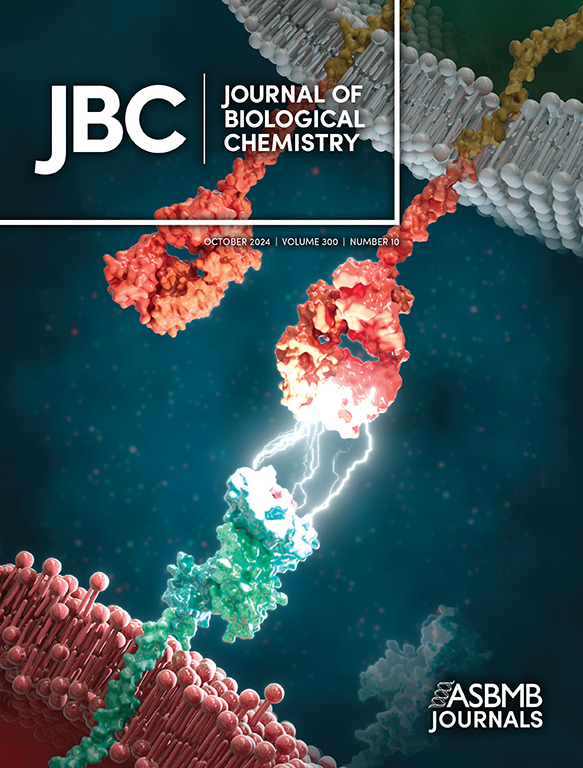与TRIO PH2结构域β3-β4环内神经发育障碍相关的遗传变异释放GEF2活性的自抑制。
IF 4
2区 生物学
Q2 BIOCHEMISTRY & MOLECULAR BIOLOGY
引用次数: 0
摘要
TRIO蛋白含有两个鸟嘌呤交换因子(GEF)结构域GEF1和GEF2,它们通过激活Rho家族gtpase来协调细胞骨架重排。影响TRIO GEF1功能的罕见变异与自闭症谱系障碍、发育迟缓和智力残疾有关,但在整个基因中也发现了变异。GEF1促进Rac1和RhoG上的GTP交换,而GEF2激活RhoA。虽然GEF1和GEF2具有共同的结构,但TRIO GEF1 (PH1)中的pleckstrin同源(PH)结构域有助于其活性,而GEF2 (PH2)中的PH结构域抑制其对RhoA的激活。在神经发育障碍(ndd)患者中发现了TRIO PH2独特的β3-β4环的一系列单点变异,但它们如何影响TRIO GEF2活性尚不清楚。利用体外荧光法评估GEF2在RhoA上的交换活性,我们证明了β3-β4环内的变异减轻了GEF2的自抑制作用。RhoA的激活抑制神经2a (N2A)细胞的神经突生长。GEF2在N2A细胞中的表达可显著减少神经突的生长,而激活GEF2变体的G2211E的表达增强了这一作用。总之,我们的研究结果揭示了GEF2自抑制的关键相互作用和结构限制,以及该机制如何成为ndd相关变异破坏的目标。本文章由计算机程序翻译,如有差异,请以英文原文为准。
Genetic variants linked to neurodevelopmental disorders within the β3-β4 loop of the TRIO PH2 domain release autoinhibition of GEF2 activity.
The TRIO protein contains two guanine exchange factor (GEF) domains, GEF1 and GEF2, which coordinate cytoskeletal rearrangements by activating Rho family GTPases. Rare variants that impact TRIO GEF1 function are associated with autism spectrum disorder, developmental delay, and intellectual disability, but variants are also found throughout the gene. GEF1 promotes GTP exchange on Rac1 and RhoG, while GEF2 activates RhoA. Although GEF1 and GEF2 share a common architecture, the pleckstrin homology (PH) domain in TRIO GEF1 (PH1) assists its activity, while the PH domain in GEF2 (PH2) inhibits its activation of RhoA. A series of single point variants in the unique β3-β4 loop of TRIO PH2 has been identified in patients with neurodevelopmental disorders (NDDs), but how they impact TRIO GEF2 activity is not known. Using an in vitro fluorescence-based assay to assess GEF2 exchange activity on RhoA, we demonstrate that variants within the β3-β4 loop relieve GEF2 autoinhibition. Activation of RhoA inhibits neurite outgrowth in Neuro-2A (N2A) cells. GEF2 expression in N2A cells significantly reduces neurite outgrowth, and expression of the G2211E activating GEF2 variant enhances this effect. Together, our findings reveal key interactions and structural constraints for GEF2 autoinhibition and how this mechanism is a target for disruption by NDD-associated variations.
求助全文
通过发布文献求助,成功后即可免费获取论文全文。
去求助
来源期刊

Journal of Biological Chemistry
Biochemistry, Genetics and Molecular Biology-Biochemistry
自引率
4.20%
发文量
1233
期刊介绍:
The Journal of Biological Chemistry welcomes high-quality science that seeks to elucidate the molecular and cellular basis of biological processes. Papers published in JBC can therefore fall under the umbrellas of not only biological chemistry, chemical biology, or biochemistry, but also allied disciplines such as biophysics, systems biology, RNA biology, immunology, microbiology, neurobiology, epigenetics, computational biology, ’omics, and many more. The outcome of our focus on papers that contribute novel and important mechanistic insights, rather than on a particular topic area, is that JBC is truly a melting pot for scientists across disciplines. In addition, JBC welcomes papers that describe methods that will help scientists push their biochemical inquiries forward and resources that will be of use to the research community.
 求助内容:
求助内容: 应助结果提醒方式:
应助结果提醒方式:


